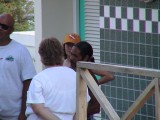|
|
|
|
Curacao 2001June 16, 2001 through June 23, 2001
|
|
My sister clued me in to this trip, the participants of which were mainly from the Rodale's Diver-To-Diver message board. Coordinated by Kevin of Blue Largo Adventures (a D2D member), flight arrangements were obtained through Maduro Dive Fanta-seas. We stayed at Habitat Curacao (Habitat Dive Resorts home page). Much like my Bahamas 2000 page, this page actually gives a trip overview, including some advice you might need to take your own trip, and then indexes the dives below, so you can skip to them if you'd prefer. What The Heck Is Curacao? Curacao is an island in the Dutch Antilles, off of the northern coast of Venezuela. It is 61 km long, and 14 km wide at it's widest (5 km at it's thinnest). It's pronounced (as far as I know) "Ku-ra-saow". I found a decent map to give you an idea of it's location; it's right between Aruba and Bonaire. The island is very dry, and hilly. Goats run wild, so if you're driving, watch for them. It's my guess that the island is at least partially formed by tectonic subduction, which means that, as the plates shift, one of the plates cuts below the plate Curacao is on, effectively pushing the island "up". Why do I think this, since I haven't looked it up to be sure? Well, on the side of the island the Habitat was on, there were few beaches; mostly some cliffs leading about 20-30 feet down to the water, and then around another 10 feet past that. Then it was flat, out to the ledge, where it dropped off, though not always with a wall (but at least a steep incline), for often an indeterminate depth. The same cliffs that made up the coast could also be seen farther inland. Pre-Trip Notes Get your passport squared away well before the trip. It can take a while, depending on where and how busy the regional office is, to get your passport dealt with. Get your gear squared away, too. Figure out what you're going to take with you, and what you're not going to take with you (hint: you shouldn't need to take weights). No other form of ID is used to get to Curacao (or to get back into the US from Curacao, I guess), unlike the Bahamas. Flying Pointers My story is that my flight leaving Tampa for Miami was late, and originally only allowed 45 minutes for me to go from my landing in Miami to my take off for Curacao ... barely enough time to allow my luggage to make the connection. In addition, American Airlines was originally not going to check my third bag; though not listed on the signage about "Baggage Embargos," Curacao was under one such embargo. So, here are the things to remember:
Where We Stayed Habitat Curacao was where we called home when we weren't out diving or being tourists. And, to be honest, we really didn't need to go anywhere else. The Habitat has air conditioned rooms, a nice restaurant, and has an excellent house reef. Two boats (they brought a third over from Bonaire for us) go out in the morning; at least one goes out in the afternoon. They have lockers to store gear right at the boat dock, which also has a dock used for shore dives. There is also a small beach nearby for those who want to lay out and get sun there; and there's a nice pool as well. The dinner meal plan, particularly if you're a big eater, is probably a good idea for you. the lunch meal plan isn't that bad either, but you have to eat quite a bit to make it worth while. The Habitat was also in the process of building additional facilities or rooms, I don't know which ... it will be interesting to see what it's like in a year or so. As the sun would rise every morning, it would take a while for the light to get to us; east of the resort there were steep, high hills. Until the sun was a bit higher, there was no direct sunlight. The evening would bring beautiful sunsets; with the clouds making the view quite interesting. Just so it's clear: This is not only a must visit ... but so far, it has a high potential for being a multi-visit locale. What Else You Need To Know US Dollars are accepted pretty much everywhere ... an American traveler can spend his or her dough without even seeing any of the local currency. My experience was that if you were going to spend a majority of your time at the resort, and very little in town, traveler's checks are a waste of time, and a small bit of cash (probably around $200) would hold you ... but you'll want to be careful how many times you say "Charge it to my room," as, come checkout, you'll be signing a very large VISA bill! Diving Nitrox is available, but for a week of diving the prices can add up ... and you can see just as much diving air. Most of our profiles involved starting out deep (going down the line, following the reef to the drop off, leveling off between 70 and 90 feet) and then slowly making our way in steps up to shallower depths. These profiles tend to allow for a lot of off-gassing later in the dive, providing you're diving a computer. Our standard was at least two dives a day, with usually a third dive on the house reef in the afternoon or at night. My Dives I missed the checkout dive due to my late arrival on June 16th. Also, on the morning of the 18th my new video camera housing flooded (my fault), and though the camera was rescued, it was under repair until the afternoon of the 20th ... so no pics on the June 18th dives (it was kind of a fit of depression that had me only wanting to dive and not caring about pictures), and only stills (from the recently replaced Sea&Sea Mx5) on the June 19th and June 20th's Bullen Baai dives. Also, I think you can note a definite progression in quality of picture and video from the earlier dives to the later ones ... I started to use the filter more often, and I just plain got better at using the new camera. On To The Dives
Pictures!Land Pictures. |
|
By Eric Stewart - The Dive Log - Blog - Mastodon © 1999-2025 Eric Stewart - Contact: eric@ericdives.com - Wanna use what you see? This site is ad free. |




